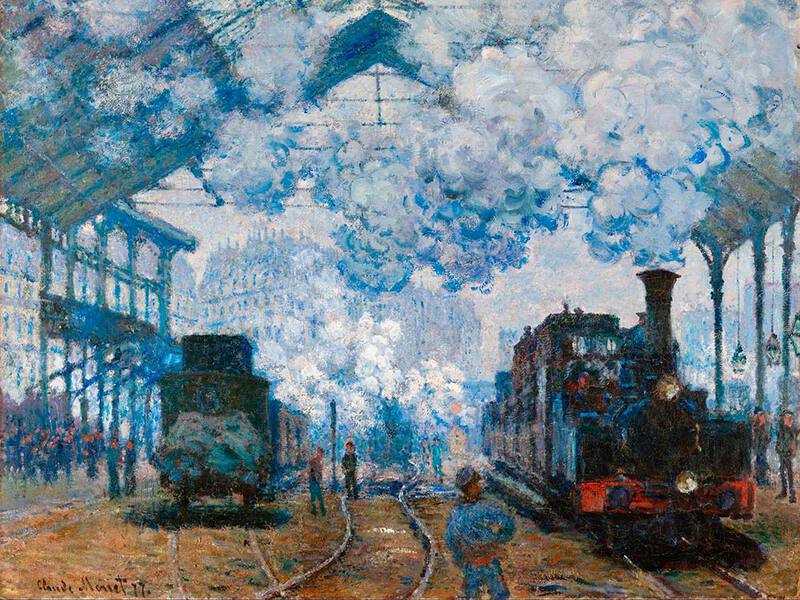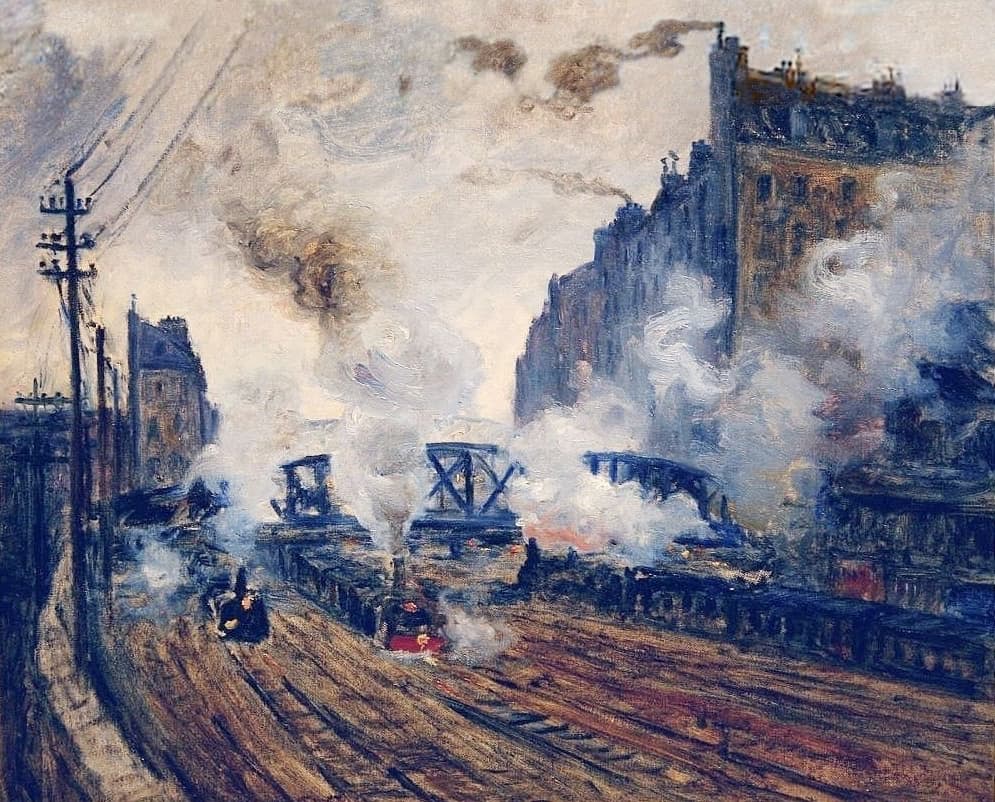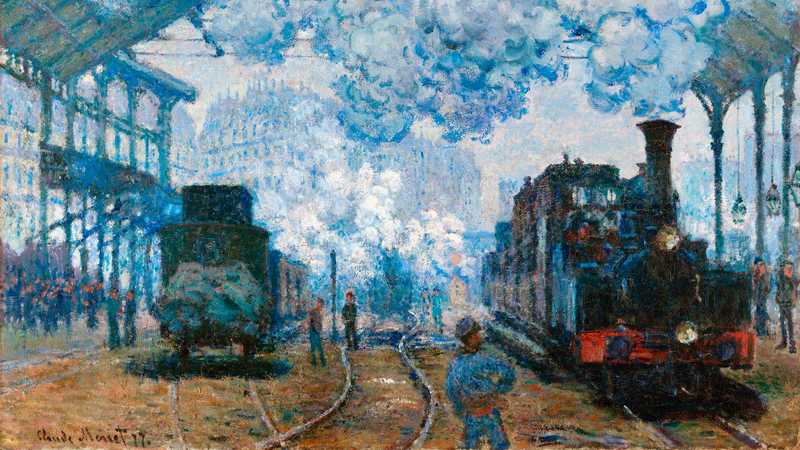1. The ‘Gare Saint-Lazare’ Series
Within the art industry, historians and critics alike have struggled over how many individual images actually form the ‘Gare Saint-Lazare’ group.
Among professional galleries, the general consensus is that the collection is made up of 12 canvases, listed above. Since it was Monet’s very first series, it is tricky to confirm whether his pencil illustrations of the same location also count in the collection. One thing is clear, the sheer amount of work Monet devoted to the Parisian railway is burning proof of his passion for the industrial space.

| Title | La Gare Saint-Lazare |
|---|---|
| Dimensions | 75 x 105 cm (30 x 41 in) |
| Current location | Musée d’Orsay |

| Title | La Gare Saint-Lazare, arrivée d’un train |
|---|---|
| Dimensions | 82 x 101 cm (32 x 40 in) |
| Current location | Fogg Art Museum |

| Title | La Gare Saint-Lazare, le train de Normandy |
|---|---|
| Dimensions | 59.5 x 80 cm (23.5 x 31.5 in) |
| Current location | Chicago Institute of Art |

| Title | La Gare Saint-Lazare |
|---|---|
| Dimensions | 53 x 72 cm (21 x 28 in) |
| Current location | National Gallery |

| Title | Le Pont de l’Europe, Gare Saint-Lazare |
|---|---|
| Dimensions | 64 x 81 cm (25 x 32 in) |
| Current location | Musée Marmottan Monet |

| Title | Les Voies à la sortie de la Gare Saint-Lazare |
|---|---|
| Dimensions | 60 x 80 cm (24 x 31 in) |
| Current location | Pola Museum of Art |

| Title | La Gare Saint-Lazare, les signaux |
|---|---|
| Dimensions | 65 x 81 cm (26 x 32 in) |
| Current location | Lower Saxony State Museum |

| Title | La Tranchée des Batignolles |
|---|---|
| Dimensions | 38 x 46 cm (15 x 18 in) |
| Current location | Reinhold Würth Collection |

| Title | Extérieur de la Gare Saint-Lazare, effet de soleil |
|---|---|
| Dimensions | 60 x 81 cm (24 x 32 in) |

| Title | Extérieur de la Gare Saint-Lazare, arrivée d’un train |
|---|---|
| Dimensions | 60 x 72 cm (24 x 28 in) |

| Title | La Gare Saint-Lazare, vue extérieur |
|---|---|
| Dimensions | 60 x 80 cm (24 x 31 in) |

| Title | La Gare Saint-Lazare, vue extérieur |
|---|---|
| Dimensions | 64 x 81 cm (25 x 32 in) |
2. What is the current value of Claude Monet’s ‘Gare Saint-Lazare’ series?
Since its conception, the ‘Gare Saint-Lazare’ compilation has made waves in the art world with approximately 8 of the original 12 works being displayed at the ‘Third Impressionist Exhibition’ in August 1877.
Since the turn of the century, Monet’s masterpieces have acquired further recognition. Many are now situated in museums across the globe from the United States to Japan.
Furthermore, a few paintings in the series are kept by private investors. Every single work in the ‘Gare Saint-Lazare’ is now estimated to be worth over £1 million. In 2018, a pair from Monet’s set, both of which hold the title ‘La Gare Saint-Lazare, vue extérieur’, found new homes. The first was purchased in New York for $32.9 million while the second was sold in London for £24.9 million.
The double sale caused such an impact that auctioneer Keith Gill exclaimed of the latter: “it is one of the most important paintings by Monet to be sold […] in the past 20 years.” A breath-taking amount of money, Monet’s work sets a lofty standard for how much Impressionistic art can be worth in the modern day.
3. ‘Gare Saint-Lazare’ 1877
Drawing quick sketches alongside making oil studies, Monet planned and completed his ‘Gare Saint-Lazare’ project within the space of one year.
After gaining permission to be on site, he spent the period viewing the station from various vantage points. From here, he constructed an assortment of compositions, depicting the railroad from differing angles.
Throughout the series, Monet selects points of interest with purpose, letting them build the atmosphere of the location autonomously. When combined with his figurative painting technique, the bustling business of life in the station instantly come to life.

The darkened silhouettes of staff scurry by in some works. Meanwhile, rounded brushstrokes confidently denote the enormous puffs of steam billowing into the air from the engines. With subdued hues of brown and blue, Monet portrays the vast architectural structures of the train sheds and station platforms, adding a literal framework to contain the rest of the scene. Creating dappled skies made of pale tones, he produces a simplistic background and, in doing so, lets the action in the foreground take the limelight.
Although there are common denominators that appear in all 12 works, by visiting the railway at different times of day, the light quality and weather conditions varied from picture to picture. As an Impressionist, the fluctuating conditions were a gift to Monet. He stated: “The light constantly changes, and that alters … the beauty of things every minute”.
At the front of the canvasses sit shiny, bulky and mechanical steam engines. They juxtapose with the travellers who are dressed in their finest attire and the backdrop of majestic Parisian townhouses. In these works, old and new tussle for attention. Interweaving with the ever-flowing smoke, figures appear like ghosts as they go about their journey. Though they are physically motionless images, Monet creates an unceasing sense of movement. The series is set dramatically apart from his earlier pastoral works and he rises to the test, showcasing his versatility as an artist in the ‘Gare Saint-Lazare’
4. What was Monet doing when he painted the ‘Gare Saint-Lazare’ series?
Before painting the ‘Gare Saint-Lazare’ series, Monet was living in self-imposed exile. This was due to two reasons: the first was that he had married Camille Doncieux, a union that his father did not approve of.
The second was that he wished to escape conscription, which would have forced him to fight in the Franco-Prussian war. Consequently, Monet moved to The Netherlands with his new wife in 1870. During this decade, they also lived in Great Britain to escape the effects of the war.
While abroad, Monet congregated with other Impressionist artists who had similarly relocated. In particular, he met with Charles-François Daubigny and Camille Pissarro. Together they enjoyed trips to Holland and England’s most eminent art galleries.
Monet was predominantly drawn to landscapes, both industrialised and naturalistic. He cites the paintings of British artists John Constable and JMW Turner as being hugely inspiring in these years. It is evident from the style of ‘Gare Saint-Lazare’ that witnessing the work of these two masters had a definite effect on how Monet tackled the theme.
After spending time in the countryside, Monet eventually returned to Paris. On returning, he found the capital had been transformed. Due to the damage of war, along with the great minds of turn-of-the-century engineers, the city was being transformed and modernised at a breakneck pace. The railways were revolutionising domestic life and driving the changes. This was a stimulating topic for the young painter.

Monet also created ‘Gare Saint-Lazare’ in response to one of his own pieces, ‘Impression, Sunrise’. A mass of smooth orange and purple hues, ‘Impression, Sunrise’ is renowned for its striking and simple layout. In comparison, the paintings of ‘Gare Saint-Lazare’ are filled to the brim with interlocking elements; their boldness is reflected by Monet’s impasto brushwork. It is intriguing to see Monet address the twists and turns of his own career; it was as if he were having a conversation with his former self, using his newer paintings as the interviewer.
5. Making art on location
To execute his ‘Gare Saint-Lazare’ series, Monet had to gain permission to set up an easel on location at the station.
He had originally considered Paris’ other major station, ‘Gare du Nord’, but settled on Gare Saint-Lazare when the railway director of the travel company ‘L’Ouest’ agreed to the artist’s request.
The venue itself was vital to the way Monet’s paintings shaped themselves. With around 13 million customers per year by 1870, the station was central to Parisian life. Additionally, during the second half of the century, the Gare Saint-Lazare was going through a series of improvements and extensions to manage the massive influx of passengers.
Using vivid and viscous paint, Monet captures this ascent into the industrialised age. He drew images of Gare Saint-Lazare’s first iron and glass train shelter, designed by the engineer Eugène Flachat, as well as its steam-powered trains.
The ambience of these paintings is often noted by art critics. Monet himself articulates this writing: “smoke from the engines [is] so thick you can hardly see a thing […] it's a fascinating sight, a real dream”.
6. Changing perspectives on ‘Gare Saint-Lazare’?
The influence of the ‘Gare Saint-Lazare’ series had a significant impact on his contemporaries in the artistic circles of Paris.
It is thought that the renowned writer Émile Zola based his book ‘La Bête humaine’ (1890) on Monet’s work. The novel is a psychological thriller set on the line between Paris and La Havre. It dutifully embodies the time period with Zola’s characteristic Realist style, echoing Monet’s paintings.
As a series, the ‘Gare Saint-Lazare’ was so ground-breaking that Monet now has his very own gallery, the ‘Musée Marmottan Monet’, in Paris. The institution holds over 300 of Monet’s Impressionist and Post-Impressionist artworks.
The paintings are also significant due to their context. The technological innovations of early steam engineswould have been electrifying for a nineteenth-century audience. From the 1930s onwards, picture-perfect postcards of trains became popular and it is possible that the ‘Gare Saint-Lazare’ series helped ignite this trend.
Similarly, with the freedom to analyse Monet’s work today, contemporary viewers are able to witness a slice of history. We are able to enjoy the sight of a station which moves at a slower pace than the ones we are used to. Perhaps that is the poetry of Monet’s ‘Gare Saint-Lazare’ series: images that were seen as exciting and hectic in the 1800s seem serene in the 21st century, giving them continued relevance for modern viewers.





